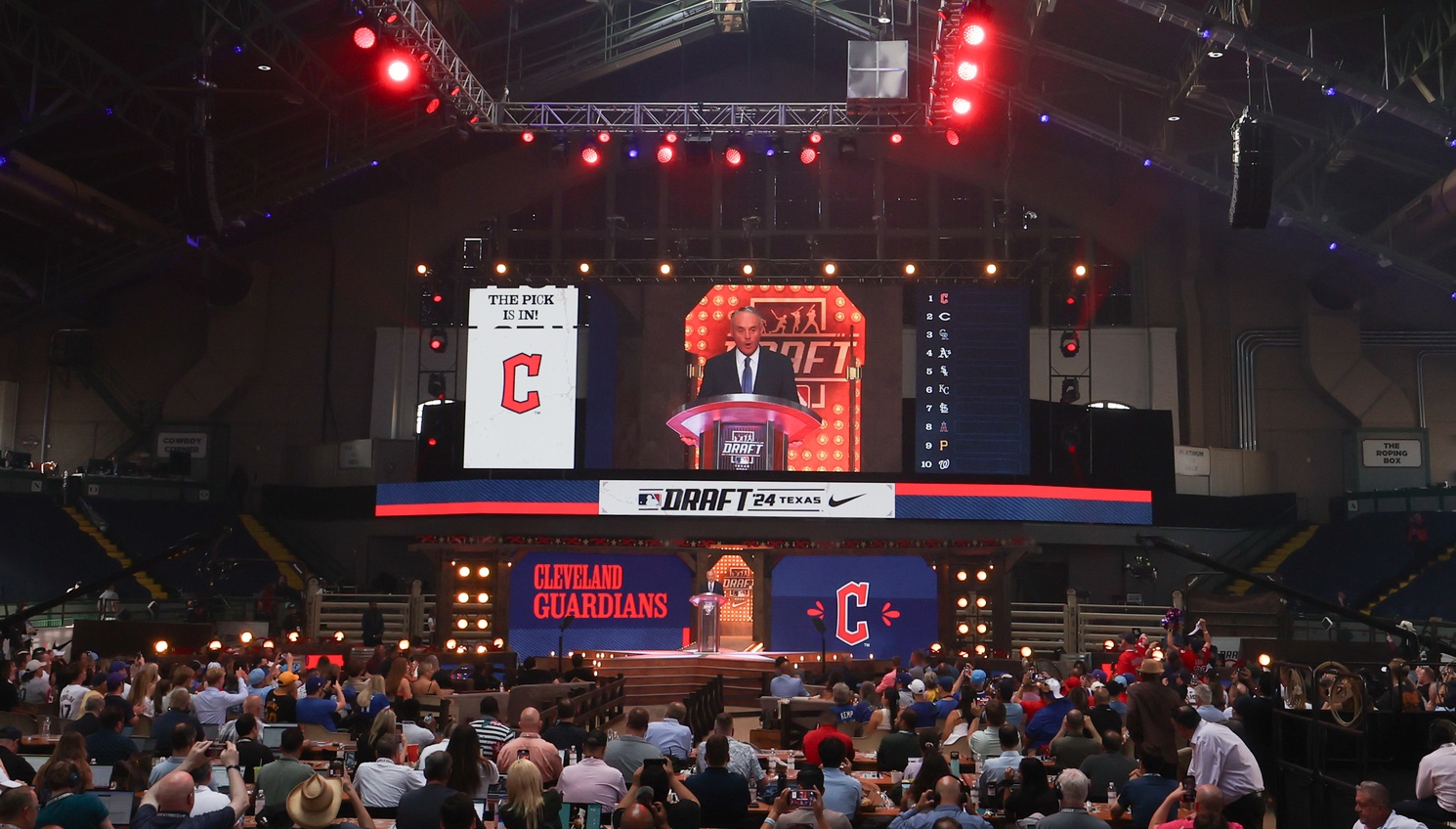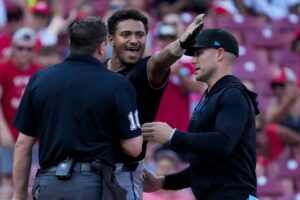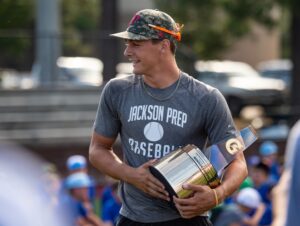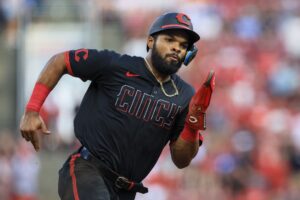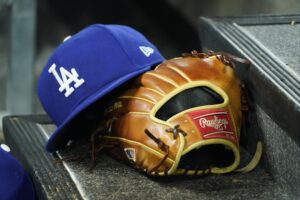The 2024 MLB Draft is here. Teams will come together to make their picks with an eye toward the future. The draft will again be part of All-Star week and will feature 20 rounds, with the first 74 picks– the first two rounds, compensatory rounds, Competitive Balance Rounds and prospect promotion incentive selections on the first night. Days 2 (Rounds 3-10) and 3 (Rounds 11-20) begin at 2 p.m. ET on Monday and Tuesday.
2024 MLB Draft Picks: Round 1
The Mets, Padres and Yankees first-round picks dropped ten spots because they exceeded the second surcharge threshold of the competitive balance tax by more than $40 million.
1) Cleveland Guardians: Travis Bazzana, 2B, Oregon State
Entering the weekend, the Guardians still hadn’t decided on this pick. Travis Bazzana came to the United States and made an immediate impact at Oregon State. He upped his value with 11 home runs and 26 steals, then raised his profile when he won the Cape Cod League batting title (.375) and MVP Award. Bazzana, a left-handed hitter, is compact and strong with great bat speed. He has an advanced approach at the plate with a ton of raw power. He’s proven he can lefties and rights, and a plus runner who can be a legitimate base-stealing threat. He’s going to get a lot of attention in the blank system.
2) Cincinnati Reds: Chase Burns, RHP, Wake Forest
Chase Burns is the first pitcher selected in a July following a strong junior season that included Atlantic Coast Conference Pitcher of the Year accolades and the NCAA Division I lead in strikeouts (191 in 100 innings). Burns throws at 97-99 mph and can reach 102 mph with his heater. His tight slider is his true beat that sits in the upper 80s and has generated a 60 percent swing-and-miss rate during the last two seasons. He also owns a plus low-80s curveball but rarely uses his upper-80s changeup. Burns has a history of throwing strikes and his overall command improved this spring. However, he needs to locate his fastball with more precision at the professional level. He has the ceiling of a frontline starter but comes with a bit of reliever risk.
3) Colorado Rockies: Charlie Condon, OF/3B, Georgia
The 2024 Golden Spikes winner had an all-time great junior season. Charlie Condon led the nation in batting average (.433) and home runs (37) while posting a 1.565 OPS and collecting 233 total bases in 60 games. He has top-of-the-scale raw power that plays from foul pole to foul pole and his combination of bat speed, strength and leverage allows him to mishit balls but still drive them out of the park. After splitting time between first base and the outfield corners as a freshman, he has played all three outfield spots and third base this spring. He’s not quick enough for third or center, but Condon does have the solid-to-plus arm strength and can provide average defense in left or right field.
4) Oakland Athletics: Nick Kurtz, 1B, Wake Forest
Wake Forest recruited Nick Kurtz as a left-handed pitcher but emerged as a dominant hitter. Kurtz batted .344/.498/.695 with 39 home runs in his first two college seasons. He got off to a slow start in 2024 but went on a rampage afterwards. Kurtz’s signature tool is his well-above-average power in all fields. He has outstanding bat speed, strength and a left-handed stroke to drive balls in the air. Burns is more than just a slugger, he’s a complete hitter who comes with no discipline weakness. He controls the zone, covers the entire plate and hits the ball all over the ballpark. He could turn into Jim Thome but one with defensive value.
5) Chicago White Sox: Hagen Smith, LHP, Arkansas
No left-handed pitcher in the draft has better stuff than Hagen Smith. He won Southeastern Conference Pitcher of the Year honors and led NCAA Division I in average-against (.144) and strikeout rate (17.3 per nine innings), setting a record in the latter category. Smith can reach 94-97 mph and touches 100 with his fastball. His best offering is an 83-87 mph slider, which features sweep and depth while destroying lefties and keeping righties at bay. He uses an upper-80s splitter as a chance of pace despite the struggles to locate it well. He has a strong 6’3″ frame built for durability and could be a frontline starter if he continues to develop.
6) Kansas City Royals: Jac Caglianone, 1B/LHP, Florida
Seen as the best two-way player in the nation, Jac Caglianone has true left-handed raw power. His Division-I leading 33 home runs backs it up. He’s very aggressive in the box, but there are concerns about his tendency to chase pitches out of the zone, he doesn’t strike out a bunch and makes tons of hard contact. He’s solid defensively at first base but struggled to find the strike zone after having Tommy John surgery. Caglianone can touch triple digits with his fastball and his 90 mph cutter is featured more than his slider.
7) St. Louis Cardinals: JJ Wetherholt, SS/2B, West Virginia
JJ Wetherholt might be the best pure hitter of the 2024 MLB Draft. The left-handed hitter can drive the ball to all fields with excellent pitch recognition and elite bat-to-ball skills. He has the ability to hit the ball all over the fence in all directions, giving him average power at the next level. Wetherholt is a plus runner who is a base-stealing threat when healthy. The one concern about Wetherholt is his defense, which he was hoping to improve, but a hamstring issue kept him from seeing time at shortstop. Even if he profiles as a second baseman, his bat is worth paying attention to.
8)Los Angeles Angels: Christian Moore, 3B, Tennessee
Christian Moore took his production to a high level this spring. Moore led the NCAA Division I with 111 hits, ranking third with 34 home runs and setting a Volunteers mark with 61 career homers. Moore can do damage with an aggressive approach. His mindset, bat speed and strength give him power that plays to all fields and 25-30 home run potential. His right-handed swing can get long but still chases too many pitches out of the zone despite making consistent contact in 2024. He can show solid speed once he gets going and looks to steal and take extra bases.
9) Pittsburgh Pirates: Konnor Griffin, SS/OF, Jackson Prep (MS)
Gatorade’s National High School Player of the Year possesses five-tool potential. Konnor Griffin’s 6’4″ frame adds some length to his right-handed stroke but has issues he’s working out at the plate. Griffin can control the strike zone well and makes regular contact. His combination of electric bat speed, strength and leverage could translate into 30-home run power as he learns to drive the ball in the air more consistently. Griffin also has well-above-average speed, giving him 30-30 upside. Scouts project Griffin as a plus defender at shortstop and a possible Gold Glover in center field.
10)Washington Nationals: Seaver King, 3B/OF, Wake Forest
Seaver King started games at four positions for Wake Forest. King is good at putting the ball in play with a compact right-handed stroke geared for hitting line drives to all fields. He needs to work on his plate discipline due to too many swings and chases, making a ton of weak contact. With above-average speed and solid arm strength, King is a versatile player. He opened this season as a center fielder before settling in at third base and seeing some action at shortstop. He is best valued at shortstop.
11) Detroit Tigers: Bryice Rainer, SS, Harvard-Westlake (CA)
Brice Rainer has many tools in all directions. Rainer has a strong build and while his wing used to get long at times, a stronger Rainer can make consistent hard contact from the left side of the plate. He owned the top four exit velocities at the NSHI in April and has shown he can drive the ball to all fields. There aren’t many questions about where he might play defensively. He ran and played better at shortstop over the spring, record plus run times. If he had to move to third base, he could be a Gold Glove-caliber defender there. The Texas recruit has garnered many comparisons to Corey Seager.
12) Boston Red Sox: Braden Montgomery, OF, Texas A&M
Braden Montgomery is the highest-drafted position player in Aggies history. He surpasses Tyler Naquin (No.15 overall in 2012), despite breaking his right ankle in the Super Regionals. Montgomery launched 27 home runs this spring after transferring to Texas A&M. A switch-hitter with strength and a quick, aggressive stroke, does more damage as a left-handed hitter. Montgomery’s improved plate discipline comes with his ability to handle breaking balls in the last two seasons. With average speed and plus-plus arm strength, Mongtomery fits best in right field.
13) San Francisco Giants: James Tibbs III, OF, Florida State
Florida State was pleased with the efforts of James Tibbs III. He hit 17 home runs and slugging .682 as a sophomore in 2023. Tibbs put himself even more on the map by continuing to hit with a wood bat, hitting .303/.390/.472 with six home runs in the Cape Cod League over the summer. The left-handed hitter is confident and smart at the plate, with an approach he’s improved during his time at Flordia State. He cut his strikeout rate by upping his walk rate considerably from his freshman to sophomore seasons. Tibbs is seen as a left fielder due to his below-average run and some scouts see him at first base.
14) Chicago Cubs: Cam Smith, 3B, Flordia State
How much Cam Smith can hit will help dictate how consistently he can get to his plus raw power. He struggled to stick to an approach and have quality at-bats during his freshman year. He often chased pitches out of the zone, but that has improved in the Cape Cod League. His miss rate went down from 29 percent to 19 over the summer as Smith continues to keep the swing-and-miss to a minimum. His ability to duplicate what he did on the Cape has allowed him to be the kind of player who is on the horizon.
15) Seattle Mariners: Jurrangelo Cijntje, RHP/LHP, Mississppi State
Jurrangelo Cijntje can pitch from both sides of the mound. Scouts see Cijntje as a Marcus Stroman-esque starter as a right-hander against profiling more as a reliever as a left-hander. He can throw with a 94-96 mph fast from the right side that tops out at 98 mph. He backs it up with a mid-80s slider that reaches 91 with good depth. As a southpaw, he works from a low slot with a sweepier low-80s breaking ball a low-90s heater that doesn’t miss too many bats.
16) Miami Marlins: PJ Morlando, OF, Summerville (SC)
PJ Morlando has an advanced feel to hit, showing the willingness to work counts and to make two-strike adjustments. He has bat speed and strength, but the pop he displays in batting practice hasn’t translated into game power this spring. He can get pull-happy and his left-handed swing can get uphill on occasion. He’s destined for left field or first base, making power imperative. He’ll be 19 on Draft Day and is eligible again in 2026 if he attends college at South Carolina.
17) Milwaukee Brewers: Braylon Payne, OF, Lawrence E. Elkins (TX)
Braylon Payne, a left-handed hitter, has very fast hands and creates plus raw bat speed. He has consistent loud contact both in batting practice and in games. He has the speed to play good defense and the athleticism to make big plays, long and confident strides to the ball and good hands at the ball.
18) Tampa Bay Rays: Theo Gillen, SS/2B, Westlake (TX)
Theo Gullen has a disciplined approach, quick hands and a sweet left-handed swing. His hitting ability will allow him to get most of his plus raw power, giving him a 20-homer floor. He should develop more pop as he adds more strength to his physical 6’2″ frame. The Texas recruit has better range to his left than his right at shortstop. He could become an offensive second baseman at the next level.
19) New York Mets: Carson Benge, OF, Oklahoma State
The Cowboys turned Carson Benge into a hitter after his elbow gave out. He’s a legitimate prospect both ways, showing first-round potential at the plate and third-round potential as a pitcher. A left-handed hitter, he controls the strike zone and uses the opposite field exceptionally well. Benge has average speed and is quicker once he gets going. He’s a solid defender with plus arm strength in right field. He could fill in as a center fielder on occasion. He’s intriguing as a quick-armed right-hander with a fastball that reaches 96 mph, a solid slider and the makings of an average changeup. However, Benge prefers hitting and has focused on that more this spring.
20) Toronto Blue Jays: Trey Yesavage, RHP, East Carolina
Trey Yesavage dominated as a junior, finishing among NCAA Divison I leaders in ERA (2.02, fourth), strikeouts (145, fifth) and average against (.154, second) while establishing himself as a first-round draft pick. Yesavage has a quality four-pitch arsenal highlighted by a mid-80s slider/cutter with more depth than lateral movement. His fastball hits at 93-95 mph and peaks at 98 mph. He also has a low-80s spike curveball and a splitter with similar velocity. Yesavage has some effort in his delivery but it doesn’t prevent him from throwing strikes. He looks like a mid-rotation starter after refining his control and consistency with his stuff.
21) Minnesota Twins: Kaelen Culpepper, SS, Kansas State
A right-handed hitter, Kaelen Culpepper has a disciplined approach that prioritizes making consistent contact and using the entire field. He has well-above-average bat speed and enough strength to produce average power. He has at least plus strength and is a potential Gold Glover at third base, though that position demands more power production than shortstop.
22) Baltimore Orioles: Vance Honeycutt, OF, North Carolina
Vance Honeycutt comes with at least plus tools across the board except for one thing: his bat. He carried a 30 percent strikeout rate as a freshman, cut it down to 20 percent as a sophomore and it went back up to 28 percent in his junior year. He has a decent right-handed swing but needs to refine his pull-heavy approach. He has good speed and fine instincts, making him a baserunning threat and a potential Gold Glover in center field, where is plus arm is stronger there.
23) Los Angeles Dodgers: Kellon Lindsey, SS, Hardee (FL)
A premium athlete who can record 8-grade run times, Kellon Lindsey has already taken a step forward in all aspects of the game. He has a short, right-handed sing geared to making contact and sending line drives up the middle. He may never be a huge power guy, and he does need to add strength, but he’s started to catch the ball out front. He has solid strike zone awareness with good swing decisions and takes walks against lesser competition.
24) Atlanta Braves: Cam Caminiti, LHP, Saguaro (AZ)
A cousin of Ken Caminiti, Cam Caminiti is one of the youngest players in the draft. Caminiti, who is committed to LSU, is a solid two-way player who could be a prospect as a hitter but switched to pitching with strong performances on the summer circuit. The left-hander has the potential to have four legitimate pitches in the future, with projection to all of them. He throws hard with a fastball that can touch 98 mph. He commands well and it misses a lot of bats thanks to ride and carry up in the zone. He can show a distinct curve and slider, though it can get loose due to inconsistencies to finish. He didn’t use his changeup much in the past, but it became a real go-to pitch for him.
25) San Diego Padres: Kash Mayfield, LHP, Elk City HS (OK)
Kash Mayfield creates extension with his fluid delivery and repeats it well. The Oklahoma State recruit is a bit scary for some teams due to a lack of track record and data from the showcase circuit. After working with an upper-80s fastball last spring, Mayfield is dealing at 92-95 mph and reaching 97 with arm side run and carry. He already has an advanced changeup that parks in the low 80s and drops at the plate. His slurvy upper-70s breaking ball stands out more for his ability to locate it than its power or shape.
26) New York Yankees: Ben Hess, RHP Alabama
Ben Hess‘ best offering is a four-seam fastball that sits at 92-96 mph and reaches 99. His mid-80s slider with two-plane depth gives him a second-plus offering and he can turn it into a shorter, harder cutter. He also can employ an average mid-70s curveball to give batters a different look but has lost faith in a fading mid-80s changeup. He has the upside of a No.2 starter but will need to throw more strikes to reach it.
27) Philadelphia Phillies: Dante Nori, OF, Northville HS (MI)
Dante Nori has a mature approach at the plate, controlling the strike zone and looking to make consistent contact in all fields. He has a quick, direct left-handed swing and will shorten his stroke with two strikes. He focuses on producing line drives rather than launching balls during games. A Mississippi State commit, he chases down balls from gap to gap as a no-doubt center fielder and his solid arm strength is another asset.
28) Houston Astros: Walker Janek, C, Houston
With impressive speed and good strength, Walker Janek creates plus raw power that translates into average game pop with most of his home runs runs driven to his pull side. While he’s an aggressive right-handed hitter, he’s showing more patience and doing a better job of using the entire field in 2024. However, he has below-average speed, he runs better than most catchers and will steal bases if opponents don’t keep him honest.
29) Arizona Diamondbacks: Slade Caldwell, OF, Valley View (AR)
Slade Caldwell is an advanced hitter with a mature approach who makes consistent line-drive contact in all fields. While he won’t be a slugger, he has impressive bat speed and enough strength to provide 15 or more home runs per season. He’s an aggressive player who delivers constant energy has well-above-average speed and makes things happen on the bases. The Mississippi recruit is a quality defender who covers a lot of ground in center field.
30) Texas Rangers: Malcolm Moore, C, Stanford
There’s plenty of confidence that Malcolm Moore will hit at the next level. He makes tons of hard contact to all fields and has easily plus raw power he showed he can tap into with 15 home runs as a freshman. He’s shown he can have an advanced approach at the plate, including doing damage with two strikes, though he wore out catching every day in his first year of college. He’ll flash with an average arm, but it’s often more fringy. However, scouts believe some of that can be cleaned up with improved footwork.
Main Photo: © Jerome Miron-USA TODAY Sports


